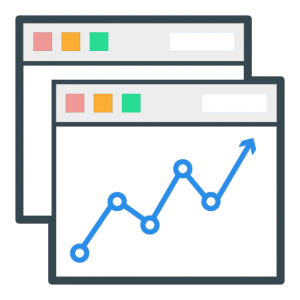Search intent is understanding what type of information users are searching for when they enter a search phrase.
Search intent is growing and evolving all of the time. In fact, “where to buy” and “near me” mobile searches have increased by over 200% in the last two years alone.
Understanding this is crucial because to rank a web page in the search engines, the type of content you create must match the content that the searcher is looking for.
Otherwise, your chances of ranking and attracting the right traffic are low and you lose ranking in the SERPs.
The remaining guide will explore search intent, help you understand what determines search intent, and explain why it needs to be considered in your digital marketing strategy.
Ready, set, go!
What are Users Looking for When They Search?
Google cares about search intent. It’s one of Google’s major goals when sending results to a user. When someone searches for a term or target keywords and finds irrelevant information, that sends a signal back to Google that the results page is mismatched for the search intent of the user.
Google then takes into consideration that information and may lower that website or page in rank next time that term or keyword is entered into the search engine.
When people search on Google, it’s not always clear exactly what they are searching for.
For instance, if someone searches “pool,” what are they actually looking for? A swimming pool, or the game of pool (billiards)?
If someone types “cookies,” are they looking for a recipe for cookies, or are they trying to understand the cookies that are stored in their browser?
You can see how a search query could mean many things!
Search engines tweak their algorithms to make sure they are displaying the results for what people want – even when it’s not explicitly clear.
Why Is Search Intent Important?
The reason this is important is that it will be very difficult to rank for your chosen keyword if your content doesn’t meet the search intent for that keyword.
This is one of the biggest mistakes in trying to rank!
Google often changes the search results for a keyword based on what they think the correct search intent is, and often displays more informational type pages vs transactional pages.
As an example, in the past, if someone searched for a health supplement, Google might have seen the search intent as “transactional,” meaning people wanted to buy the product, and therefore displayed product pages.
It was easy for a brand that sold health supplements to rank their product pages for that keyword.
But then Google changed the keyword intent to “informational,” and now only articles about the supplement are ranking. Now it would be very difficult for a brand to rank a product page there.
Even though it’s the same keyword, because Google now sees the search intent differently, you’ll need to create a different type of content.
This is a very common scenario, and why creating long-form content around your products or services gives you a higher chance of ranking versus trying to rank your product or service pages.
Just having a general understanding of the different types of search intent is vital for improving your business traffic and conversation rates, but more on that later.
Did you know that leads from search engines have a 14% closing rate while outbound leads like cold-calling or direct mail have only a 1% closing rate? That’s a huge gap, and it proves that using SEO optimization for search intent, keywords, and other SEO methods is absolutely a must-have in your marketing strategy.
It’s important to optimize your content for search intent. Otherwise, your content won’t get traffic. You want to make sure that your product page, landing page, and blog posts match the search intent of your audience.
If people are searching for information, you wouldn’t want to show them your product page. At least not at first. But, if someone wants to buy your product, you should make it easy for them to find.
Optimizing your product pages is usually centered around commercial keywords. For example, if you sell shoes you should optimize your product page for the search term “buy women’s Skechers”
It would then be best to have blog posts or articles like “why Skechers are good shoes for women” and then aim it toward an audience with informational intent.
So how do you make sure you understand search intent?
Let me explain:
How To Determine Search Intent
Moz experts suggest that the best way to determine search intent is to research the SERPs. Type in the phrase you are targeting into Google’s search bar and examine what ranks. You’ll be able to tell what type of search intent is found within the results.
Google shows results that are the most relevant search intent for each keyword.
For example, let’s take the term “email marketing software.”
A quick search shows that most of the results are lists of the top email marketing software.
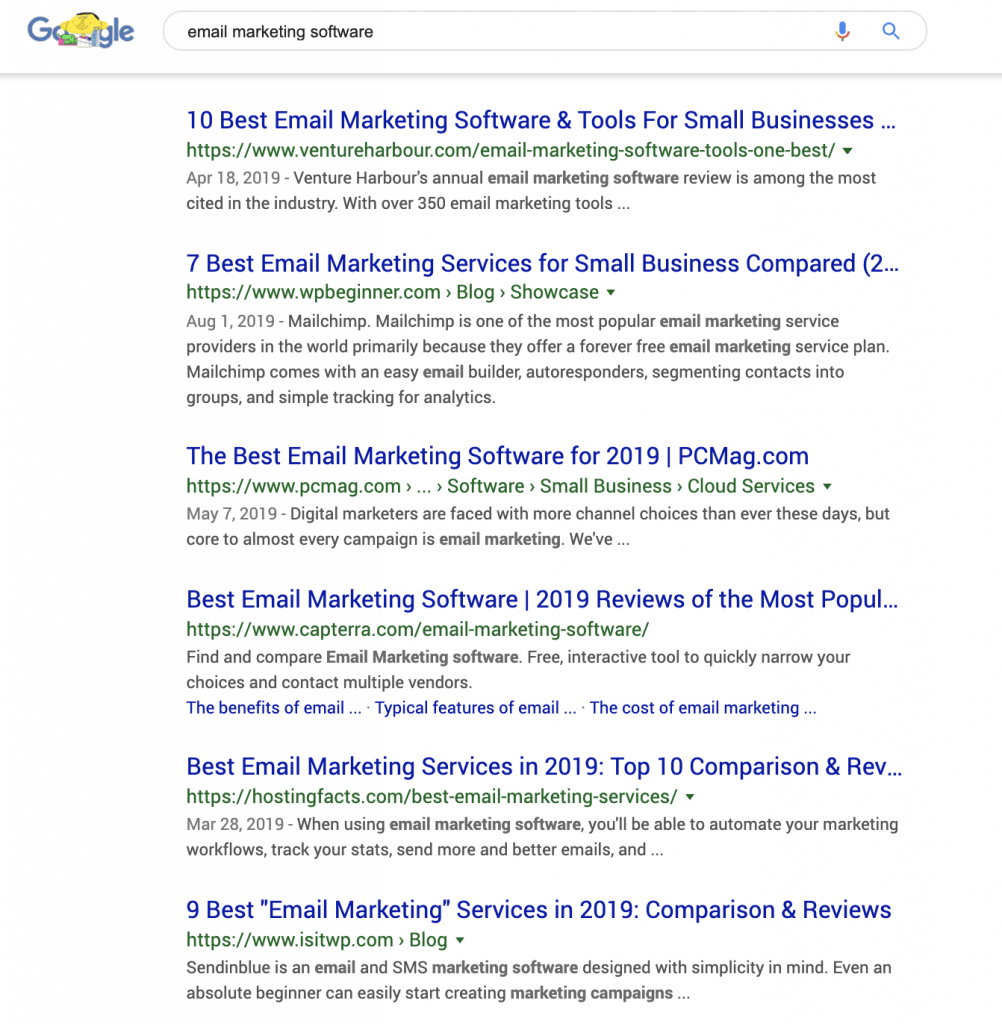
If you’re running a business that sells email marketing software and you want to rank, you’ll need to create a piece of content that matches what Google is currently ranking.
Or just type in your term and see what comes up. You’ll be able to tell by the results what Google thinks is the most relevant for your search intent.
Keywords are a great way to figure out search intent, but it isn’t enough to rank in SEO. It would be best to know more than just the best terms for your niche.
It’s a good thing that there are keyword research tools such as TheHOTH’s Keyword Planner out there that allow you to filter for knowledge panels, related questions, and featured snippets.
What is the Difference Between a User Search Intent and a Contextual Search Intent?
What is search intent really? As I stated above, search intent is the most basic part of a user’s search. It can also be referred to as audience behavior, user, or keyword intent.
People also ask, what’s the difference between regular search intent and contextual search intent? They both sound the same; however, they are a little different.
Let me explain:
Contextual search puts the content of search behavior into attention and Google bases results on that. The user’s intent and context of the keyword are taken into consideration to show the searcher the most relevant set of results.
A contextual search engine can convey questions and copies to each other according to search behavior. Major search engines like Google, Bing, and Yahoo are contextual search engines and produce contextual search intent results.
Some examples of contextual search intent are as follows:
- Demography
- Device
- Weather
- Time
- Date
- Location
- Geography
- Mood
- Past Search Results
A contextual search engine is sometimes called a semantic search engine. But, because content can be used for relevance in ranking, Google can understand questions, entities, and the user’s situation. Google’s algorithm can then confirm search intent and provide results based on individual context.
Think of it as a really intuitive way Google uses your personal preferences as a way to help give you the best results for your individual search intent.
What are the Different Types of Search Intent?
Over time, Google has improved its algorithm with many updates. Google wants to rank websites and pages that best fit the search intent of anyone using it.
Let me go into more detail about the right type of search intent. Google categorizes search intent into several main categories:
Informational intent
Information intent means users are looking to get more information on a topic. Informational search is basically a user who wants to know something.
That is one of the reasons that informational queries are so important. It reminds you that you need to write content that answers as many questions as you can on your relevant topic. Around 8% of searches are questions, so it’s important to give your audience the best answers.
For example, if someone searched “how to ride a bike” they are looking for a guide. The search results will display articles or videos about how to ride a bike.
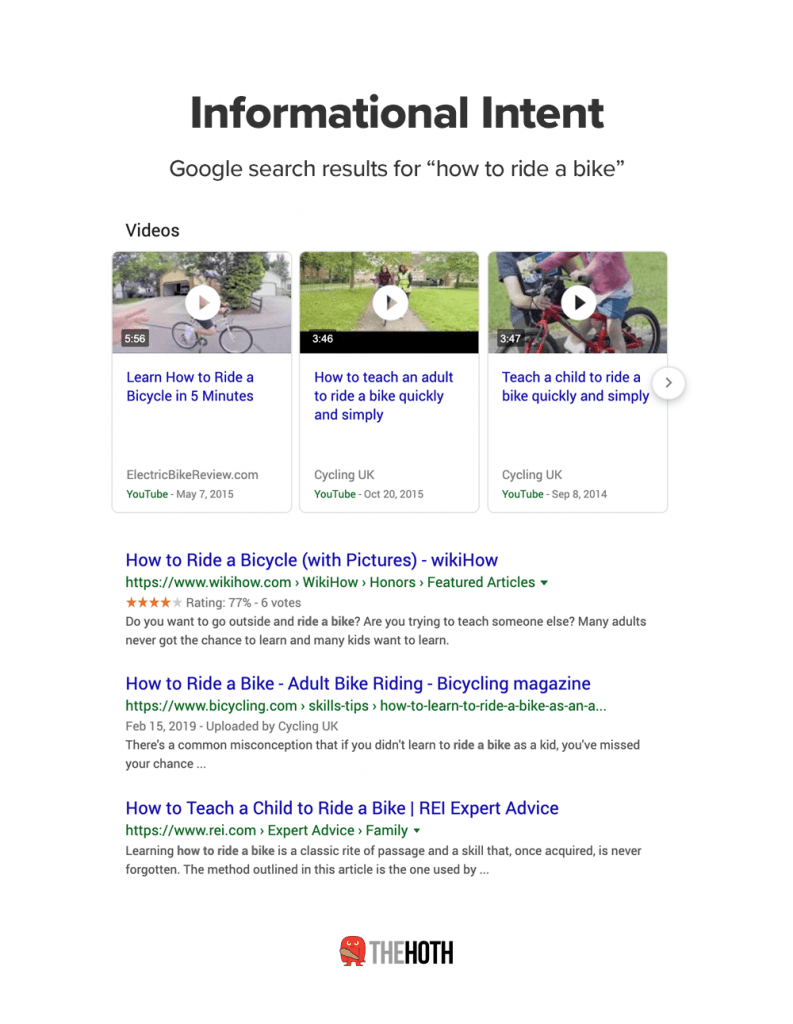
Creating relevant content that is informative is actually one of Google’s top-ranking factors. Aged content doesn’t matter to Google as long as the information holds value. Actually, nearly 60% of the pages ranking on the first result page of Google results are 3 or more years old.
Commercial / transactional intent
Commercial or transactional intent refers to when a searcher is looking to purchase something or compare prices. Actually, 53% of consumers say that they research specific products using a search engine before deciding if they are going to buy a product or service. That is considered a transactional search.
Let me break this down, let’s say for example, if someone searches for “buy blue trek bike” they are likely looking to purchase. The search results will often display product pages because this search is so specific.
This is important because around 69% of Americans shop online. This type of user intent includes a search query that has the intention of buying something. This often means that they already know exactly what they are going to buy before they search and just want to get to a product page as fast as possible.
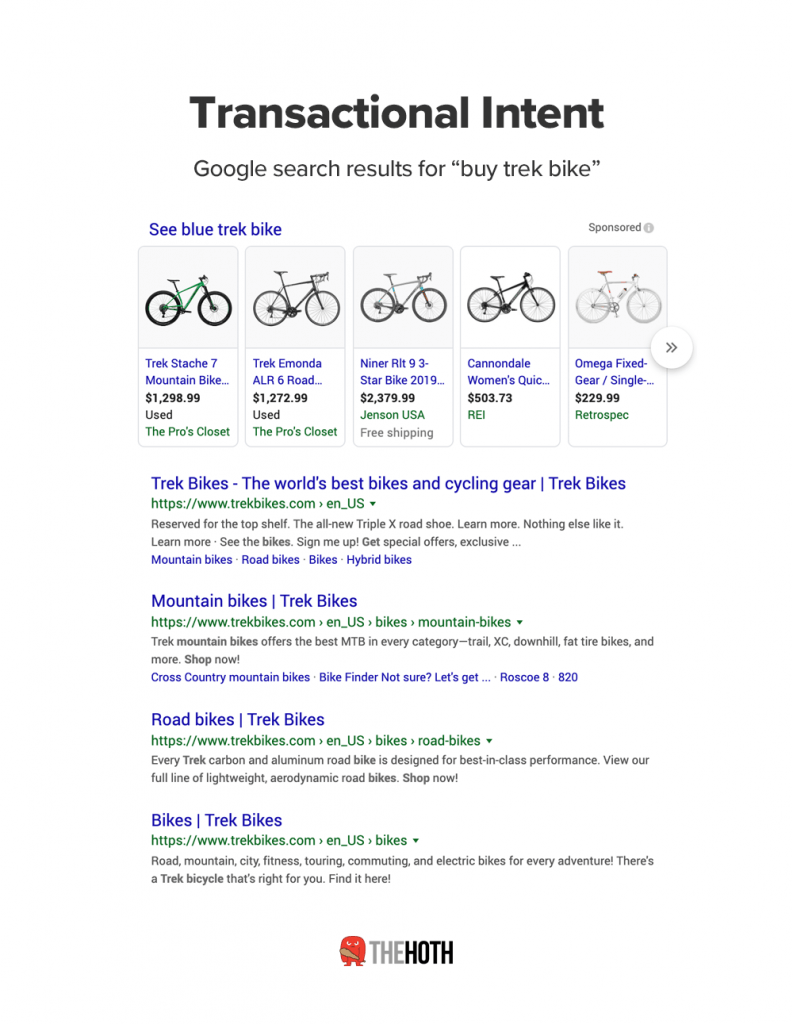
Note: Just because users are looking for products doesn’t always mean your product page will rank! Google often prefers review-type content or lists of the best products to actual product pages.
It’s important to keep an eye on algorithm updates as well. In fact, in 2020 23% of shopping intent keywords turned into informational or commercial intent. Your content should reflect a target search intent, but if that changes due to Google’s algorithm, then your rank may suffer for it.
Navigational intent
People with this type of intent want to visit a specific page or website. Let’s use Twitter for example. People who search for “Twitter” are usually just trying to find that website directly. So, you want to make sure that your site can be found when someone searches for your business name or brand.
It would be best to keep in mind that ranking high for a navigational search term is really only beneficial to your website. Because its only search intent is to actually find your brand.
Here are a few keywords you could fit into your content if you’re trying to rank in Google search for navigational intent results:
- Directions to
- Cost of
- Price of
- Hours of
- Reviews for
- Testimonials for
- Brand name
- Brand Login
- Brand Contacts
- Product or Service name
Navigational intent only occurs when a searcher is looking for a specific website or destination.
Another example would be, searchers might type “eBay login” into the search engines when they want to find the login page to Ebay.com. So, to be clear navigational intent isn’t just a main website, it can be pages off of a website such as a login or product page.
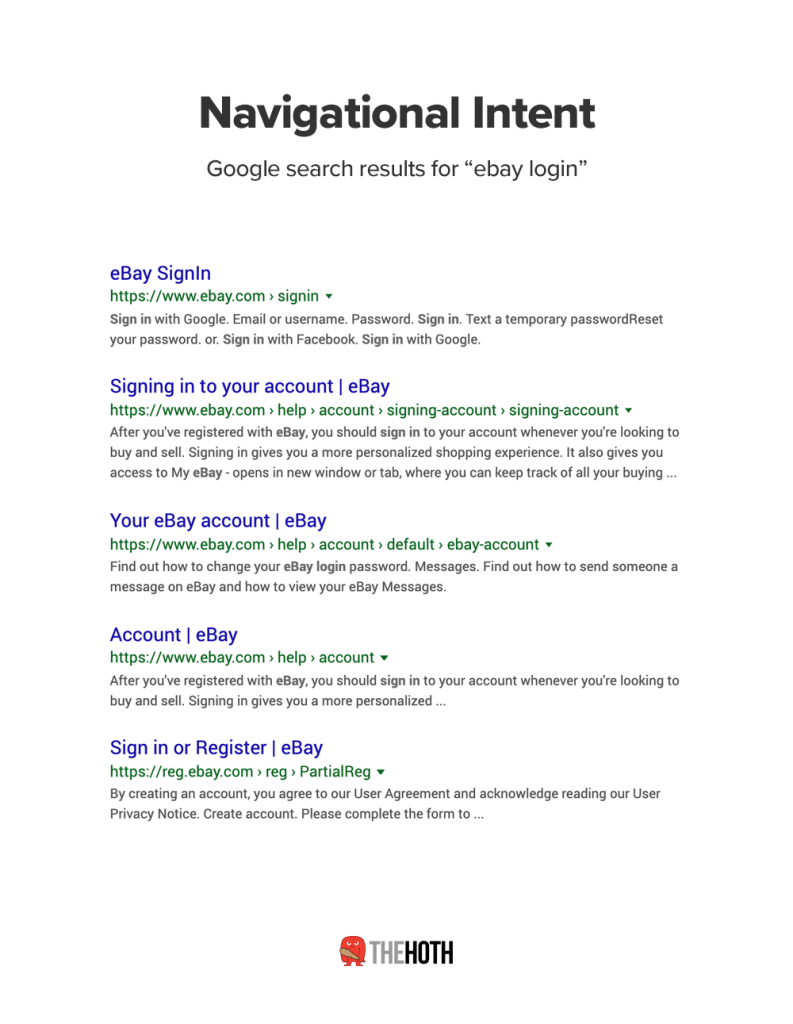
How To Build an SEO Strategy Using Search Intent?
It can sometimes be difficult to get your traffic to turn into qualified leads. Your search result has to first show up in the right places by using the best keywords for your audience’s search intent. Performing intent research as a part of your SEO strategy requires a lot from you.
Now that you have the right tools, start by asking yourself these examples questions:
- What type of content is popular within your niche? Are the top page results from these keywords from your competitors, do they offer the same service or product as your business?
- What type of structure is the top content in? Are they how-go guides, long-form content, or product pages? Knowing this information can give you an idea of what intent your keywords have.
- What search intent does your targeted keyword fall under? By understanding this you can determine if your chosen keywords match up with what you have to offer.
When you start planning out and scheduling your content creation, it would be best to go beyond just using keywords, keyword volume, and content type.
You need to keep search intent in mind and what your audience wants. This creates additional layers of content planning that in turn helps you drive relevant and qualified traffic.
Google is not only a search engine, but it’s a fantastic tool for SEO strategy creation. If you want to show up in search results, you need to do the searching yourself to see what shows up. Detail how you can format your content in a similar way to other results that have a higher ranking than yours.
Learn from your competitors and then implement it better!
How to optimize your content for search intent
By using these three factors and considering the search intent of your audience can optimize your content for SEO which turns your potential leads into customers willing to return to your website or even buy your product or service.
Here are a few additional tips to optimize your content for search intent:
- Match metadata, meta description, and content type to search intent
- Check out your competition
- Format your content
A great place to start optimization is with your page’s metadata. Update your title tags, your headings, H1s and H2s also need to reflect your target keyword.
Here are a few questions to ask yourself about your competitors:
- How do they format?
- What is the tone of their writing?
- What does their content cover?
- What are they missing that you could fill?
As I mentioned above, taking a peek at your competitors is one of the best ways to optimize your own content. You need to know what your competitors are doing so you can do it better.
Let me break it down a bit for you:
- Relevance: This is connected to your audience’s behavior. If they find the information or answers to their questions on your website, they are less likely to return to Google’s results page. This is called Pogo-sticking. You may notice a difference in click-through rate and bounce rate when your content matches the search intent of your visitors.
- Authority: Backlinks are a huge factor in improving authority; however, it’s also important to build strong internal linking that tells Google you have the content that covers everything your audience needs to know. That will increase your brand authority and visibility so you can rank for your targeted keywords and terms. If done right, this satisfies search intent.
- User satisfaction: This part is a bit self-explanatory. You simply need to create content that holds enough value to make it relevant to your audience and keep them coming back.
By considering the above you can optimize your content for your targeted audience’s search intent. Keywords, phrases, terms, search history, and even location can all play a part in search intent. Creating and planning a content strategy based on a user’s intent can boost your rankings, traffic, sales, and qualified leads.
Let’s Wrap Up Search Intent
Search intent is so important to understand when trying to come up with the best SEO strategy for your company. You need to understand navigational intent, informational intent, and transactional intent. By using these different forms of user intent, you can boost your sales and rank.
Just by grasping the intention of your audience, you can create meaningful and helpful content that provides the best answers, landing pages, and services that your target audience wants to see, visit, and buy from.
Need a little help? Schedule a call with one of our SEO experts for advice or consultation.
Don’t forget to sign up for free and take full advantage of all of our SEO guides, tools, and resources!

